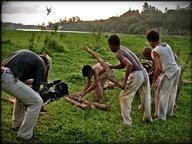Quiz Answer Key and Fun Facts
1. What coastal slave ship was taken over by its enslaved passengers in 1841 and sailed to Nassau, where the slaves were tried and freed under British law? Not the more famous Amistad, this ship makes one think more of New Orleans cooking.
2. What man tried to take over the armory at Harpers Ferry, Va. in 1859, starting probably one of the most famous slave revolts today, although he was soon captured and hanged?
3. A freeman, who was named after a country, tried to organize a large rebellion in 1822 in Charleston, S. C., but he was caught and the rebellion broken up before it could begin. What was his name?
4. A group of slaves at Igbo (Ibo, Ebo) Landing, Georgia, took a legendary action in 1803. They had been stolen from Africa, but finally overpowered their captors as they reached Georgia. What did they do next that was, quite literally, a way to start the trip back to Africa, while permanently ending their life of enslavement?
5. What little-known 1811 rebellion consisted of several hundred slaves marching toward New Orleans, La., killing and spreading fear? It was named after a coast or shoreline that sounded as if it should be along the Rhine River, not the Mississippi River.
6. What enslaved man frightened Richmond, Va., in 1800 with a planned widespread slave insurrection? Richmond whites certainly didn't consider him an angel.
7. What white man tried to organize a slave rebellion in 1815, to try to capture Richmond and Fredericksburg, Va.? He was betrayed and boxed in, at the local jail, and barely managed to escape to Indiana.
8. On what now-famous ship did kidnapped Africans attempt to regain their freedom through an uprising in 1839 and then a court case in 1841? The ship's Spanish name, "friendship" in English, didn't fit with all the animosity towards its passengers.
9. Southampton County, Virginia, August 21, 1831. Who is about to start an uprising and turn everything upside down?
10. When the Virginia legislature met in the winter of 1831-1832, it discussed the slave uprising that had occurred the summer before. Among many ideas, what did the legislature propose as a way to end slave rebellions in Virginia, but did NOT vote for?
Source: Author
littlepup
This quiz was reviewed by FunTrivia editor
gtho4 before going online.
Any errors found in FunTrivia content are routinely corrected through our feedback system.
